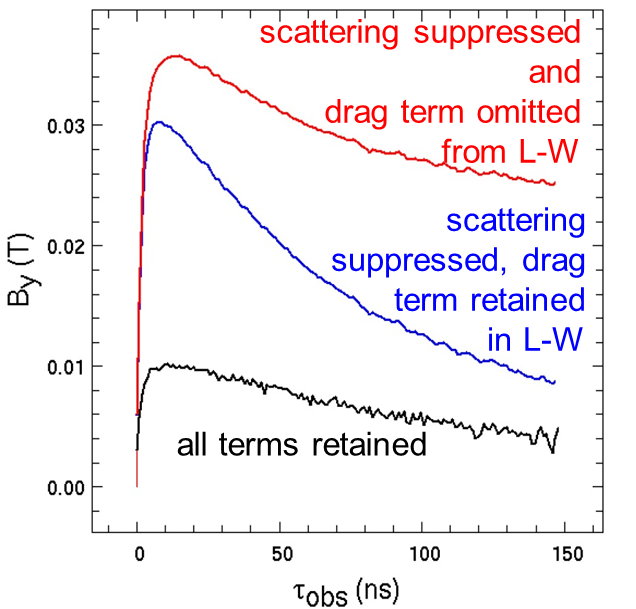David Larson (15-ERD-066)
Abstract
Modern assessment of electromagnetic pulses is essential for developing nuclear forensic capabilities based on signals measured in the urban and space environment, predicting the propagation of pulses through the ionosphere, and establishing improved radiation-hardening standards. The essential physics involved in generation of an electromagnetic pulse has long been known. The energetic gamma rays emitted by nuclear reactions propagate through the atmosphere until they interact with neutral atoms, producing ions and energetic Compton electrons. The electrons turn in the Earth's magnetic field, generating a coherent current that, via synchrotron radiation, produces a large electromagnetic signal. We propose to develop self-consistent, three-dimensional calculations of nuclear-driven electromagnetic pulse propagation, including detailed descriptions of the domain geometry, Compton electron motion, gamma shadowing, electron avalanche, and evolution of the background medium. We plan to capture previously neglected physics using new computational methods to address the shortcomings of earlier work and to incorporate recent findings, such as those indicating that the rise time computed with established one-dimensional codes is spuriously short and that gamma shadowing can increase the field amplitude, both by an order of magnitude. We will leverage the LLNL-developed WARP time-dependent plasma code framework in creating a state-of-the-art electromagnetic pulse code.
We expect that our new capability will enable us to simulate high- or low-altitude nuclear bursts, including three-dimensional geomagnetic effects and complex geometries that will be supported with the novel use of adaptive mesh refinement and with full self-consistency. The new methods and careful optimizations we develop will also afford accurate simulations of electromagnetically large problems. We will follow a stepwise approach to the development and initial exploitation of electromagnetic pulse simulations that advance the state of the art and correctly account for physical effects that have not been treated self-consistently in the classical treatments using simplified models. We are focusing on three developments that offer promise for qualitatively improved electromagnetic simulation capabilities including (1) a separation of scales to enable detailed three-dimensional simulations that are sufficiently rapid for regular use on a broad set of electromagnetic pulse scenarios, (2) a combination of adaptive mesh refinement and particle-in-cell models that offers promise for simulating a front that travels a long distance through free space before encountering an urban environment involving finer-scale structures, and (3) a pseudo-spectral solver to enable full three-dimensional propagation over distances not previously deemed practical.
Mission Relevance
Lawrence Livermore's missions in national security and strategic focus area in stockpile stewardship science will be supported with this project by providing a detailed understanding of nuclear burst effects for a range of scenarios. We will advance U.S. capabilities in identifying and quantifying threats from electromagnetic pulses, assessing electromagnetic pulse applications, developing forensics based on measured pulses, and setting hardening standards. This work also furthers LLNL's mission of nuclear threat reduction (specifically, global monitoring and consequence management), monitoring for nuclear nonproliferation, protection of space assets, and the computational engineering associated with global security (specifically, vulnerability assessments and mitigation strategies for homeland infrastructure).FY15 Accomplishments and Results
In FY15 we (1) developed a model, to be included in the full three-dimensional code, based on the Liénard–Wiechert formula for calculating the electromagnetic pulse field without the conduction current—this allows scattering, drag, and synchrotron radiation contributions to the radiated field to be examined individually and together (as shown in the figure), a capability absent in codes based on Maxwell's equation; (2) examined the effect of multiple scattering on the Compton recoil current using analytic and numerical approaches—a simplification used in legacy codes was found to neglect skewness (asymmetry) in the velocity distribution produced by electron motion and multiple scattering; and (3) developed physics modules for the three-dimensional electromagnetic particle-in-cell code, and have begun initial simulations.
A Liénard–Wiechert (L-W) Monte-Carlo solver allows close examination of the various processes contributing to a radiated field for assessing electromagnetic pulse propagation.
Publications and Presentations
- Farmer, W. A., and A. Friedman, “Effect of multiple scattering on the Compton recoil current generated in an EMP, revisited.” IEEE Trans. Nucl. Sci. 62, 1695 (2015). LLNL-JRNL-668928.
- Friedman, A., et al., Studies of EMP generation using a Liénard–Wiechert formulation, and progress toward a 3-D EMP code. (2015). LLNL-JRNL-673748.
- Friedman, A., et al., Studies of EMP generation using a Liénard–Wiechert formulation, and progress toward a 3-D EMP code. Hardened Electronics and Radiation Technology (HEART) Technical Interchange Mtg., Chantilly, VA, Apr. 21–24, 2015. LLNL-CONF-667262.






